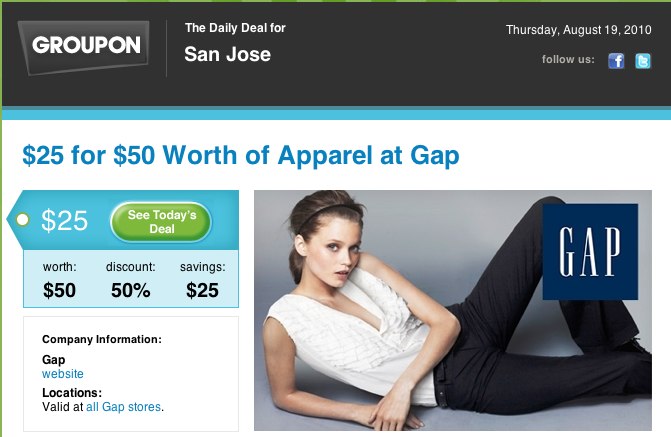Groupon's $11 million Gap day: A business winner or loser?

Before I say anything about Groupon's $11 million day last week, I should note that my wife was among the 445,000 shoppers who coughed up $25 for a voucher that will let her buy $50 worth of stuff at the Gap.
That was the deal of the day on Thursday, the first nationwide deal for the Chicago-based Groupon, which has been expanding across the nation - and now internationally - with what has largely been targeted local discounts.
Who doesn't love a half-off sale? In my house, it's still back-to-school season and $25 in savings is $25 in savings. So I'm a happy dad. And I can't imagine anyone at Groupon is sad about the way this all turned out. After all, the Chicago-based company, not even two years old, has received a fair amount of publicity in the past few days.
But digital marketing consultant Augustine Fou, quoted in a Mashable post, says this is loser of a deal for an large-scale national advertiser like the Gap unless the company is taking the losses on the deal out of a marketing or advertising budget. The reasoning: the $11 million in transactions for the day is actually $11 million in losses because, at $50, the revenue should have been $22 million and Groupon still gets its cut, too.
Talk about glass half-empty, huh? Technically, Fou is right - if you assume that every one of those 445,000 would otherwise walk in the door of a Gap store and spend at least $50. But that would be a bad assumption, right? Many of those discount shoppers might have never been inclined to walk into a Gap store. Many might have walked in, shuffled through a couple of racks and went off to spend $25 or $50 elsewhere.
Off the top of my head, I can come up with at least a handful of reasons why this is a good deal for the Gap and probably many other advertisers, both large and small.
- Cash-in-hand: As with gift cards, a Groupon customer has already spent the money. Someone - whether it's Groupon or The Gap - has it in-hand, theoretically making interest on it until the customer redeems it.
- Word of Mouth: When people hear about a big sale, they immediately tell their friends. I know I saw the deal being spread across Facebook and Twitter that day.
- Extra spending: I can almost guarantee you that my wife will take my teen daughter into The Gap and spend more than $50. In fact, they'll probably end up spending $75. My wife will explain to me how she saved me money because I really got $75 worth of stuff for $50, which I was probably going to spend anyway. (This is why I don't go school shopping with wife and daughter.)
- Free advertising: The Gap's name was in headlines alongside Groupon's name. And a big "$11 million" in bold never hurts either.
- Exposure: Sure, the Gap is already a big name but small customers can grab the attention of potential new customers and turn them into repeat customers.
That's already worked for me with one company, Los Angeles-based ScanDigital, which converts old reel-to-reel movies, among other things, into digital formats. About a month ago, I spotted a Groupon for $100 worth of services for $40 and jumped on it. (I bought two.)
I sent off 12 priceless 8mm home movies that date back nearly 50 years to be converted into digital formats. They were just returned this weekend and I was very happy with the service. Now, I'm looking forward to using the second voucher on some old camcorder tapes that have recorded memories of first crawls, first steps and first birthdays.
And a good friend of mine, who has boxes of old films, tapes and so on, has been looking for a referral of a place that can be trusted with his family's memories.
Sure, going the route of a Groupon deal cost ScanDigital $60 on my order (actually $120 for the two vouchers I bought.) But, I did end up spending far more than $100 and the company gained a repeat customer and a referral.
In the end, I'd say the $60 was worth it.